June 2023
The Boyne River Keepers (BRK) held a successful Ladies’ Night event to help raise funds for the boat dock they plan on building at the central Ryall Park location.
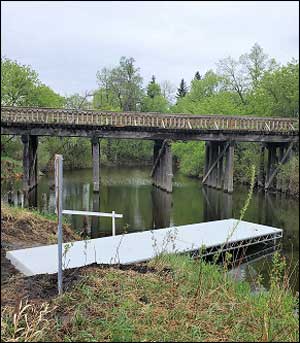
The new BRK dock
Boyne River Keepers. This new interest in the outdoors has had a positive effect on the activities of the BRK, the group that is working to revitalize the local river. We’ve seen this winter how their activities made the Boyne a center of outdoor fun. The group recently received funding for a dock from which folks can launch their canoes and kayaks and enjoy a summer of outdoor family fun. The aluminum dock is now in place just north of the old Midland Bridge.
Ideally, this is where we should add one of our ‘Now and Then’ rollover photos, showing the river as it was a century ago. Unfortunately, these photos are another temporary casualty of the pandemic. You’ll have to use your imagination, along with this photo from the Dufferin Historical Museum to flip back to earlier days of recreational boating on the Boyne.
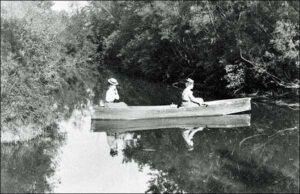
Early 1900s outing on the Boyne River
March 2023
The weather hasn’t put a damper on local heritage activities. Presentations of Chris Larsen’s and Nikki Falk’s video “Voice of the River” have been warmly received by both the local Councils and residents of Riverview Legion Place retirement home This creative video tells the story of this local lifeline from the perspective of the river itself. You can view the video on the Boyne River Keepers website. Well done, ladies.
November 2022
Locally, the BRK just pulled their dock from the river for the winter and are now awaiting the arrival of skating season. If we look back to earlier years, it seems that skating was well under way by Remembrance Day. The Dufferin Leader (November 10, 1910) reported that:
The Boyne has been frozen over for some time and the ice is now about three inches thick. Some of the younger generation have already enjoyed the pleasures of skating. Except a slight flurry about three weeks ago, there has been no snow.
And the Dufferin Leader, November 11, 1926 under the heading “Skaters Busy On River”, recorded the following:
The freezing temperatures of the nights of the past week have resulted in a good sheet of ice forming on the surface of the waters of the Boyne and this, with the absence of snow, makes things very nice for those who like to skate. A party of boys went up the river yesterday to a point about six miles west of town and found the going fine.
Two winter freeze-ups don’t make the argument for climate change but it will likely send some of you off in search of data on a few more annual freeze-up dates. Let us know what you find.
September 2022

World Rivers Day. It turned out to be a fine, autumn afternoon for the Boyne River Keeper’s annual commemoration of World Rivers Day. Fifty-three boaters in pirate costume joined the procession of canoes and kayaks that enjoyed a relaxing afternoon paddling down the river from the trestle dock to Ryall Park. In the picture left, C/D MHAC Chair Nikki Falk carries the BRK pirate banner as she arrives back at Ryall Park to check in with the home crew.
Back at the park, landlubbers visited displays set up by local merchants and organizations and enjoyed musical entertainment. C/D MHAC and the Dufferin Historical Museum (DHM) shared a display table featuring a piece of the original waterworks pipes, vintage photos of the river and local surroundings, and an assortment of publications and brochures. We answered scads of heritage-related questions and enjoyed hearing personal memories of the river, notably from the many folks who recalled happy times at the old swimming hole. There are so many fascinating stories out there, just waiting to be told.
Some of our younger visitors couldn’t imagine swimming in the river rather than in the ‘clean’ local pool, although recent BRK activities had made them aware of the fun of boating and winter sports. It was a reminder of the importance of encouraging families to share their stories across generations. As our favourite author, Anon., once said: “The most treasured heirlooms are the memories that we pass down to our children.”
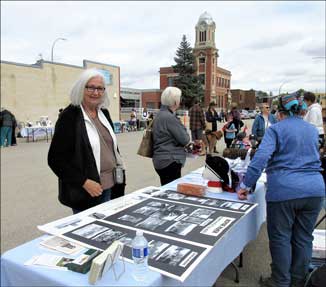
August 2022
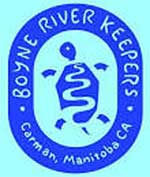
BRK logo
Boyne River Keepers (BRK). In our May update we noted, for example, that the Boyne River Keepers (BRK) had asked C/D MHAC to write a history of the river. You’ll find our story of the Boyne River history . We are pleased to report that they now have their new website up and running. The group will be celebrating World River Day September 24 with events on the river and in Ryall Park. C/D MHAC has been invited to attend and to set up a display. Check out their site to learn more about their projects and upcoming events.
May 2022
History of the river. We mentioned last month that the Boyne River Keepers (BRK) had requested our help in writing a history of the river for their new website. The group’s interest in the past has been piqued in part by the ‘heritage moments’ Nikki Falk has been presenting at BRK meetings.
We’ve often mentioned the river on our own website, mainly because it has featured in so many aspects of local heritage. Now we’ve been going back over that content and pondering how best to present a history that would be meaningful to the BRK.
From what perspective should the story of the river be told? We recognize that histories are interpretations of the past, based on the narrator’s own experiences and view of the world. Most of our local sources—histories, life stories, photos and newspaper accounts—date from the post-1870 era and reflect the experience and viewpoint of early settlers and their descendants. These river stories speak primarily of floods, pollution, dams, bridges and recreation.
What if the story of the river were told by the Indigenous people who lived here in the centuries before 1870? Given their different perspective on nature, an Indigenous history likely would focus more on the life-giving importance of water, ceremonies, plants and animals native to the area, or the best places to find medicinal herbs. This part of our local heritage was passed from one generation to the next by oral tradition. So far, we haven’t retrieved these early stories of the river we now know as The Boyne.
What if the river were to tell its own story? What would it have to say about its use and abuse by human cohabitants?
Identifying and preserving local heritage is an ongoing process. We’ll continue trying to fill in the gaps in our knowledge by seeking out oral histories and memories of the past. We’re also taking careful note of the new chapters of river history being written by groups such as the BRK. That said, here is an outline of what we know so far about the history and heritage of the Boyne River.
History of the Boyne River. The story begins centuries ago when glacial Lake Agassiz receded, leaving behind an expanse of rich prairie soil and a winding stream that drained the land between the western escarpment and the Great Marsh1 east of present-day Carman. From there, the water flowed into the larger Red River drainage system. Although the Great Marsh itself was drained in the early 1900s, the river remains a key factor in local water management and a major feature of the Carman/Dufferin landscape. Of equal significance is the role the river has played in our local heritage.
The river, with its heavily forested banks, was a source of fresh water, fuel, wild fruit, medicinal plants and small game for early Indigenous hunter-gatherers. During the era of the fur trade and western exploration, larger rivers and waterways provided the fastest and most efficient means of transportation. Although our river was too shallow and meandering to serve as a major transportation route, it played a crucial role in the history of that era.
April 2022
History requests. The Boyne River Keepers (BRK) committee has asked our group to help them write a history of the river. As anyone who has been following our website over the past decade is aware, stories of the river date from centuries past and touch upon so many aspects of local heritage. We are working at the moment on consolidating these stories into a more comprehensive account of this valuable and sometimes neglected natural resource.
March 2021
The more fortunate among us have rediscovered the outdoors and gardening or maybe found time to catch up on all those DIY projects tucked away in the back of our minds for the ‘someday’ that finally arrived. Cupboards and closets have never been cleaner. Then there are a few seemingly natural-born recluses who look back at the last months as a sort of vacation from meetings and routine, a time to read, soak up nature, and just do what they want to do, when they want to do it.
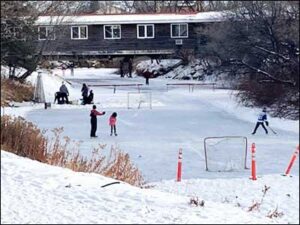
The positive side to 2020—rediscovery of the outdoors. The Boyne River Keepers have spearheaded the return to use of the Boyne by clearing what has become a well-used skating and hiking trail. As Dennis Young reported in the Carman-Dufferin Standard (2021-01-14), “The Boyne River has found new life this winter with games of shinny, avid walkers and snowshoers. The old swimming hole area welcomes visitors.”
Photo: Dennis Young, Carman-Dufferin Standard
April 2021
Boyne River Keepers. Last month we mentioned how the Boyne River Keepers (BRK) group has made the past winter a happier time for many local folks by clearing a river trail and helping them rediscover the joy of being outdoors.
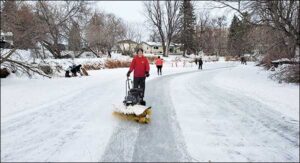
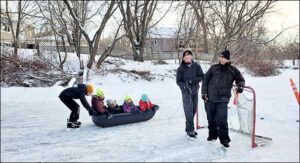
Photo courtesy BRK
With the early arrival of Spring, winter fun on the Boyne is now a fond memory. But if you visit the BRK Facebook page you’ll find a great assortment of photos such as these two as well as video clips that will keep these memories alive over the coming months. You’ll also find photos from last summer that will make you begin to look forward to months of kayaking and canoeing through the revitalized heart of Carman.
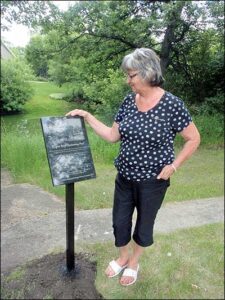
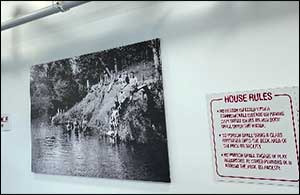

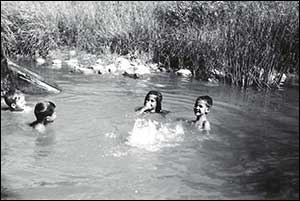
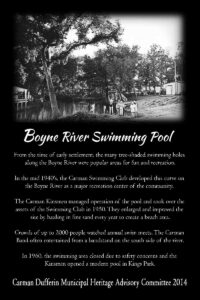
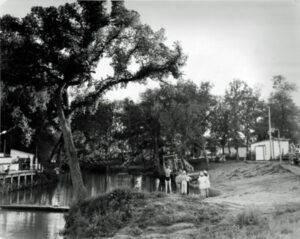
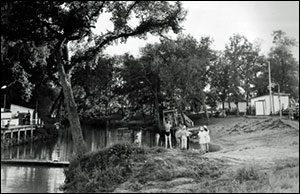
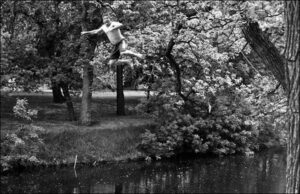
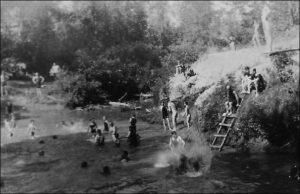
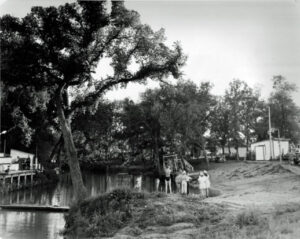
May 2019
‘Beautify the Boyne’ Project. At our May 13th C/D MHAC meeting, Nikki Falk ‘planted a seed for thought’ that she has been mulling over for the past while – the clean-up and beautification of the Boyne River.
The River runs like a thread from west to east across Carman/Dufferin municipalities. It also is one of the common threads running through our local history. With its heavily forested banks, the river was a source for fresh water, fuel, wild fruit and small game for early First Nations and Métis camps.
Later, as the Riviére aux Îlets-de-Bois, it became an oasis where hunters and fur traders following the Missouri Trail could pause and repair their Red River carts, or come in springtime to harvest the syrup of maple trees. A number of early Métis families, such as John Grant, settled in the area.
Post-1870, the river and its environs became a prime destination for an influx of Anglophone homesteaders who renamed it the ‘Boyne’. It also became part of a Métis land claim to the river and adjacent lands, from the escarpment east to the big swamp. The claim was never recognized.
In more recent history, the river has powered a flour and lumber mill, served as a source for town water and as a popular, well-used swimming hole. (For a larger view, click on the image.)
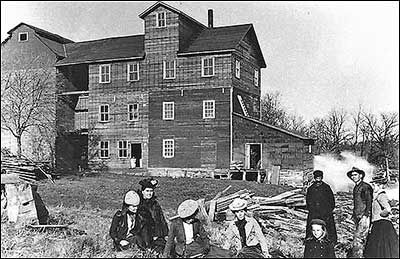
Clendenning Mill west of Boyne settlement
Until a diversion was built around the Town of Carman, floods periodically devastated the town. In the process, flood waters destroyed many early records; they also provided striking images of the power of Mother Nature.
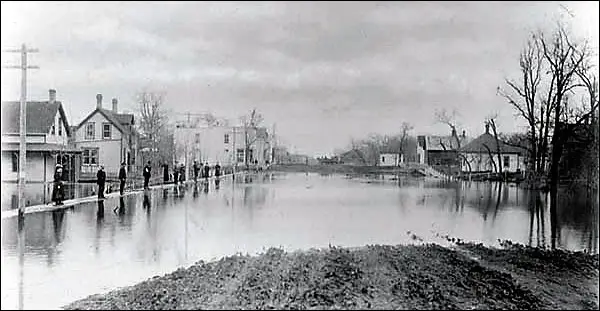
Villard Avenue during 1893 flood
Kayaking on the Boyne 2019. While kayaking this spring on the Boyne, Nikki Falk was struck by the continuing beauty and peacefulness of the river. “It felt like another world, floating along for hours with the massive trees canopied over the water. We enjoyed seeing a wide variety of different birds, fish jumping, turtles sunbathing on logs, etc. It really felt like a connection to the past, as if we were stepping back in time and experiencing just what the generations before us had, and what the future generations could have if we can only safeguard it.
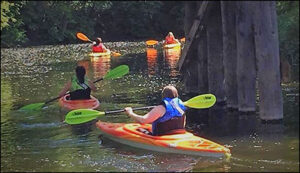
What we also sadly witnessed was the pollution, the debris caught up along the river banks, the downed trees impeding the vital water flow and finally, the realization that later in the summer the toxic algae would put a stop to our kayaking.”
This past winter, Nikki began “researching what options are available for communities for the revitalization of our rivers. How can we preserve and protect the Boyne River’s heritage for future generations to enjoy? How do we instill a sense of community stewardship to the care and well-being of our precious water resource?”
One of her key takeaways from her research on other community projects was the potential for helping the river once more become a focal point in the Town of Carman and a part of local efforts to enhance the tourist value of the Town. Ideally, respect for the river would carry through to other property owners and communities along its banks and to maintenance of one of the few remaining wildlife corridors east of the escarpment.
Expect to hear more from Nikki and her colleagues as their ideas and enthusiasm for restoring and conserving this important heritage resource take shape.
